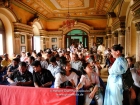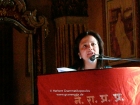I. Inauguration ceremony at NAFA (National Academy of Fine Arts), Kathmandu, Nepal, 2006
II. 108 DOORS ? THE UNEXSPECTED ANSWER
III. About doors in Tibetean culture
I. Inauguration ceremony at NAFA (National Academy of Fine Arts), Kathmandu, Nepal, 2006
This is a project over-view for the newspapers‘ press release, January 2006
II. Speach by Sangeeta Thapa, curator of Siddhartha Arts Gallery, Kathmandu, Nepal
108 DOORS ? THE UNEXSPECTED ANSWER
Khula Dhoka…. A journey through the world of imagination….
‘The Door’ symbolizes an idea, the door to dialogue, with its duality, its material but also conceptual quality, leaving us free to come or go, closing us in or letting us out. Rousing feelings of security or oppression, comfort or aggression, representing the door to freedom or imprisonment.
Nepalese of all social, cultural and philosophical backgrounds are familiar with this symbolic association with the door in society at a physical or abstract level. One hundred and eight doors have been envisaged for this project as this number is associated with spiritual significance in Nepal. Different doors could be painted to illustrate the associations this theme rouses in them. A door thus becomes a shared plane inviting us to reflect, dialogue – on a democratic footing. The door can appeal to the peoples‘ imaginations as a real concept…yet others may illustrate it through pieces of their poetry or prose.
One hundred and eight real doors, a territory to share physically and mentally; to open or to close in complete liberty. This community project focuses on inter-cultural awareness and acceptance between different communities in Nepal. It seeks to open a dialogue between Nepalese from different social, cultural and religious groups. Khula Dhoka will provide these people an innovative and novel opportunity to learn about each other, understand each other and find ways work together on achieving a common goal.
—————————————————
Khula Dhoka “Would you dare to share?”
Opening a Door….Making the first step towards
· That which is unknown to us
· That which we know little about
· That which frightens us
· That which we might consider dangerous
· That which may liberate us or imprison us
Being the Door
· The immutable vertical axis, which draws its strength from the goodness of mankind and whose compassion spreads the message of harmony across the world.
· The soft horizontal axis, which bridges communities and unites worlds, the unifying factor between two beings in disagreement, conflict or who are ignorant of each other. Humanity aims for peace, harmony within families, within cities and between people. Each one of us has the power and the duty to participate in this timeless dream.
· Today, we have consciousness, knowledge and means to reach it. But this requires the participation of: children, elderly, sick, businessmen, housewives, postmen, doctors, teachers, politicians, journalists, artists, religious figures…and all. We must dare to be creative in order to open the doors of dialogue. Today, every glance, every word should lead to peace: Consider that what you just said, and weigh if it could lead to peace. We might be naïve but with determination we can secure a future for our children and the future generation. Humanity needs a daring and innovative generation to safeguard ideals of peace and compassion.
General Considerations
The project requires four conditions:
1. to present a slide show of doors from the world over are designed to spark the powers of imagination.
2. to preserve the symbolism of the door
3. to take different forms of expression
4. to provide a meeting space for people from different cultural, ideological, and religious backgrounds
5. to launch them together in a concrete project, which makes them focus on opening doors for dialogue
6. to present the doors as works of art at the gallery.
Objectives:
The objective of the project is manifold. It is designed
1. to promote a shared work of reflection, encounter and creativity as an incentive for dialogue, partnership and peace.
2. Promote and spread the values of humanity
3. Unite people from different backgrounds and encourage them to work together and create a harmonious exchange between themselves.
4. Involve these individuals to reflect on the meaning of „doors“.
5. Enhance relations between people coming from the different communities and backgrounds.
6. Stimulate the initiatives of different ethnic communities and minorities towards a dialogue of common civic goals.
This community art project seeks to enhance encounters between disparate social, cultural and religious communities. This could be achieved through a deeper understanding of the founding texts scriptures, sacred or not, that encourage the opening of dialogue and brotherhood. It also aims to make all the vast classical humanistic masterpieces, the most articulate thoughts, research in Human Sciences accessible to the larger public and to those unfamiliar with these concepts.
To reach these objectives, this project will bring together intellectuals, researchers, religious figures, writers, poets and artists, dedicated to sharing their thoughts and art to the disposal of those who have little access to them, especially students, teachers and families.
Project Plan:
The collection of doors
· Contact possible NGO’s and interested businesses for sponsoring
· Write a professional letter to inform sponsors
· Estimate the price of the doors and paints
· Decide on their contribution and representation in the project
The doors
· The “doors” do not have any definite criteria
· Tibetan hanging cloth, glass doors, wooden doors, windows (anything that keeps the symbol of the door)
· 108 doors – due to the great religious significance of this number in Nepal
Involved Communities
· Contact different communities and children to participate
1. Buddhist/Christian
2. Hindu/Muslim
3. National/International Artists
4. Homeless
5. Homosexual
6. Disabled
7. Maoist/Army
8. Prisoners
9. Dalits/Tribals
10. HIV positive
11. Refugees/IDP’s
12. Street Children
13. Drug Addicts
14.SingleMarginalized
Women
15. Others
· Introduce the different communities to each other
· Create an awareness between the different communities
· People from various walks of life, professional artists and students will also participate in the project
The organization of workshops
· Bring Nepalese and international invitees together in a large suitable area
· 2 Nepalese/international invitees from different communities per door
· Provide all necessary materials
· Paint, brushes, aprons etc…
· Provide snacks, water and drinks for participants
· Professional artists, adults and students will also be involved in these workshops
· Organize three workshop days to allow time to complete the doors
· Doors to be sold at exhibition and proceeds given to charity OR doors to gifted to be installed in public venues
Reflection Component
· Poems and texts reflecting on the meaning of the door and its symbolic importance will also be written. These will be documented and compiled as a souvenir catalogue
· Ten poems will be selected to be turned into musical pieces. Contact possible musical groups interested in participating in the project
· A wall of written pieces will be created with all the texts and poems written during the process.
. A selection of poems and door paintings will be printed on flex banners to facilitate the transport of the exhibition to other national and international venues.
Documentary
· A documentary will be made on the process of the entire project
· Filming will take place during all workshops, interviews, and special events building to the final exhibition.
Raising Awareness
· Possible interested reviews: ECS, The Nepali Times, Himal Khabarpatrika, The Himalayan Times, Annapurna Post, Kantipur, Samay plus various TV channels …
· Ask them to promote the project and raise awareness about it in Kathmandu
Previous Doors Exhibition in Belgium 2000
Opening
Friday 15 October 2000
Exhibition from 16 October until 7 November at:
Musées Royaux des Beaux Arts de Belgique, access Museum of Ancient Art 3 rue de la Régence-1000 Bruxelles
WITH THE PARTICIPATION of:
Musées Royaux des Beaux-Arts de Belgique
Charline Mahy, artist
Wolu culture
World Conference for Religion and Peace WCRP
Fonds Parvati
Bibliothèque publique locale de Woluwé St. Lambert
Françoise Tack PhotographeCulture and Democracy
Maison Poesie Enfance
III. About doors in Tibetean culture
(Text by Peter K. Moran, Ph.D.; January 2006)
As for many cultures, in Tibet doors are thresholds: where people, spirits, and cold draughts can enter the living space or depart. In central Tibetan, home is referred to as simply „inside“ (nang), so the door is what links this inside to the larger world. In many Tibetan homes you find ritual protection drawings (srung skor), mantra, and sometimes yak horns or skulls, affixed to the outside of the main door. These keep negative influences (gnod) at bay. In the cold climate of Tibet, doors are also often covered with a cloth or curtain. These might be simple rough fabric, or finer cloths, even silk. The door cloth is not only a means of keeping out the cold and dust, it also insures a measure of privacy; at the same time, in many homes and monasteries it is decorative and ornamental. The door, as the space between inner and outer, is also a metaphor for any kind of threshold. In Buddhism, the „three doors“ refer to the three means by which beings interact with the world, and hence produce karma and its results. The three doors are the body, the speech and the mind. These are our doors to the wider world, our means of engaging with our environment and with other beings who live alongside us. Therefore, Buddhists are instructed to guard the three doors carefully, so as to do no harm through them, and to in fact to use them for the benefit of others.
Peter K. Moran, Ph.D.
Executive Director
Commission for Educational Exchange
between the United States and Nepal (USEF/Nepal)









